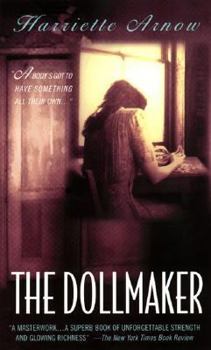The Dollmaker
Select Format
Select Condition 
Book Overview
The Dollmaker was originally published in 1954 to immediate success and critical acclaim. In unadorned and powerful prose, Harriette Arnow tells the unforgettable and heartbreaking story of the Nevels... This description may be from another edition of this product.
Format:Mass Market Paperback
Language:English
ISBN:0380009471
ISBN13:9780380009473
Release Date:March 1999
Publisher:Avon Books
Length:608 Pages
Weight:0.69 lbs.
Dimensions:1.4" x 4.2" x 6.8"
Customer Reviews
2 ratings
Real for Me
Published by Thriftbooks.com User , 21 years ago
Having grown up in rural Kentucky 'The Dollmaker' was far too real for me. Gertie is a real character, she is the typical strong and determined woman of the mountains. It is almost repulsive that she has to be paired with a man who is a weak and spineless character. Despite it all she was able to create beauty, honor her husband and children and to have dreams in all the despair. Her life is typical for so many women of rural Appalachia from that time. I would say that one who has to see the movie to critique the book needs to remember that a movie is rarely as worthy as the book. Either read the book or see the movie, most often I choose to do the former. Why let a movie ruin a good book!Stands out in my mind as one of the all time best reads, comprable to "The Good Earth" by Pearl S. Buck!
A painful, shattering tragedy, beautifully written
Published by Thriftbooks.com User , 26 years ago
This is a haunting story. In it, a unique woman with clear and powerful dreams and goals, betrays her self by listening to the advice of the average folk who surround her. In following their advice, she forever loses her chance of attaining her own dreams, and also betrays and loses 2 of her children - one of whom returns to the land they left, one of whom, tragically, dies. This is one of the most painful books I have ever read. At the beginning of the book, Gertie is portrayed as nearly superhumanly powerful in her determined success in saving her youngest child's life. Then Gertie forces herself to give up her lifelong dream of owning her own farm - when it is almost within her grasp! - to follow her husband into the ugly heap of industrial Chicago in the name of the war. She does this because she is convinced by vast numbers of average folk that it is the RIGHT thing to do. She convinces herself that her private dreams are mere selfishness, and that she should sacrifice them to "follow her man".Echoing the same mistake again later, she bows again to popular opinion, and banishes her most beloved and unique child's imaginary playmate. As an indirect result, her daughter dies. Fleeing to play alone - where none can hear/watch her with her imaginary playmate - she has a horrific accident in the train yard, and dies nightmarishly in her mother's arms. And yet, Gertie does not see that these betrayals of all that is most unique, sensitive, and artistic at her core is evil. Instead, she continues to see it as self-scrificing, when she is killing the best self she could be and sinking into the dross around her. Symbolically, at the very last, she gives up her beautiful cherrywood carving of Christ to be cut up to make mass-produced dolls; her final betrayal. Ah, no wonder she could never see his face!This story will never leave me. In many ways, I wish it would. But it teaches a hard lesson; that to be true to anything, one must be true to oneself. To a religious reader, it truly brings home the lesson of the parable of the talents. One must not misuse or waste the gifts of talent given by the creator. But, oh, poor Gertie!






